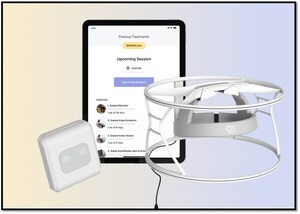BrainQ announces encouraging study results for new therapy to reduce disability after stroke
Study presented 77% of the treatment group recovered to a level of no symptoms or no significant disability on the modified Rankin Scale
JERUSALEM, March 11, 2021 /PRNewswire/ -- BrainQ, the Israeli start-up with an AI-powered therapeutic platform, today revealed the encouraging results of their Randomized Controlled Trial (RCT) which supported a recently granted request for FDA Breakthrough Device Designation. The pilot trial data will be presented as part of the International Stroke Conference between March 17-19.
In a single site, the double-blind RCT included 25 subjects. After 8 weeks of treatment, 77% of the subjects receiving the BrainQ therapy had scores of 1 or 0 on the modified Rankin Scale (mRS), the gold standard for measuring disability following stroke. This translates to subjects having either no symptoms or minor symptoms, and with no significant disability. Only 25% of the subjects in the sham (control) group scored 1 or less. Additionally, 92% of subjects in the treatment group improved by 2 or more mRS points.
The BrainQ subjects' mRS scores improved by an average of 2.5 points over the course of the study, compared with 1.3 points in the sham group. No related adverse events were recorded.
"These pilot results are striking, as BrainQ's therapy suggests a beneficial effect in the subacute phase", said Dr. Jeffrey Saver, Director of the UCLA Comprehensive Stroke and Vascular Neurology Program, and a lead Principal Investigator for BrainQ's upcoming Pivotal Trial. "The current leading interventions for stroke are effective only in the few hours post-stroke and applicable to less than 5-10% of patients. This technology may have the ability to extend the time period in which corrective therapy can be delivered from hours to days and even weeks, and be applicable to a much larger patient population."
"With 800,000 strokes each year in the US alone, this therapy has the potential to greatly advance stroke care. I'm eager to see the next phase of clinical trials."
BrainQ's therapy uses machine learning algorithms to extract biological insights from brainwaves, which are used to imitate the natural processes of neural network synchronization. The therapy is delivered to a patient via a cloud-connected wearable that transmits frequency-tuned low intensity electromagnetic fields, facilitating neuroplasticity processes within the central nervous system .
"These promising results indicate that we're on the path to bringing hope to ischemic stroke patients with limited options after acute care ends with our novel technology," said Yotam Drechsler, CEO and Co-founder of BrainQ. "As we're approaching a pivotal study with US sites, our goal is to bring our therapy to market and become the leading home-based neuro-therapeutics solution."
About BrainQ
Israel-based start-up BrainQ is developing an AI-powered therapeutic platform for reducing disability following stroke and other neurodisorders, with the goal of transforming the lives of millions. The company was recently granted an FDA Breakthrough Device Designation for its therapy and is currently conducting clinical trials in top medical centers worldwide with patents secured in all major global markets. BrainQ's team and advisory board include a unique, multidisciplinary group with extensive background in neurology, neuroscience, data science and machine learning.
The BrainQ device is limited to investigational use and is not available for sale in the United States.
About the Study
The results of the trial will be presented in the abstract titled "Artificial Intelligence-powered Non-invasive And Frequency-tuned Electromagnetic Field Therapy Improves Upper Extremity Motor Function In Sub-acute Stroke Patients: A Pilot Randomized Controlled Trial".
Endpoints & outcomes:
- FMA-UE scores are significantly higher in the treatment group at week 4 (23.2±3.91 vs. 9.9±3.2) and remain higher after 8 weeks of treatment (31.5±2.97 vs. 23.1±4.99).
- For mRS, at week 9 the treatment group showed a significantly greater decrease in disability than the sham group (2.5±0.18 vs. 1.3±0.16).
- Significant improvements were also observed in the ARAT–Pinch subscale, BBT, and NIHSS.
- No related adverse events were reported, supporting the safety of the treatment.
Media contact
Madeleine Truitt
[email protected]
SOURCE BrainQ

WANT YOUR COMPANY'S NEWS FEATURED ON PRNEWSWIRE.COM?
Newsrooms &
Influencers
Digital Media
Outlets
Journalists
Opted In





Share this article